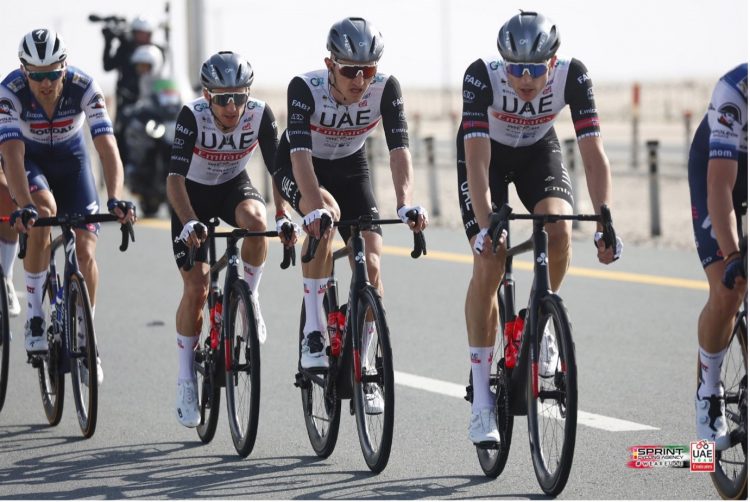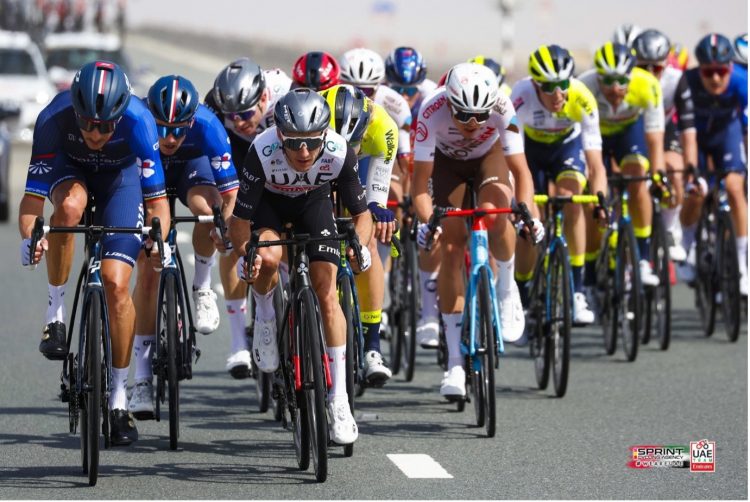An Ultimate Guide to Tour UAE
The 6th edition of the Tour UAE commences on 19th February 2024, and involves 7 stages, finishing on Sunday 25th with a mountain top finish on Jebel Hafeet. In addition to this, Stage 2 is a Team Time Trial and takes place entirely inside Al Hudayriyat Island.
Teams will consist of 6 riders and as expected, the big ones will be in attendance, such as Trek – Segafredo, Jumbo – Visma, Soudal Quick-Step and naturally UAE Team Emirates, who will be racing on home roads and will hoping for a repeat of their 2021 and 2022 overall victory.
Overview of the stages
Stage 1: AL Dhafra Walk Madinat Zayed-Liwa Palace – 143 Km
This desert stage starts with a 45 Km stretch of wide, straight roads running from north to south, later entering a region with large sand dunes, forming most of the stage. The route also includes a series of inclines and declines leading to Moreeb Dune, where races will complete two laps on a challenging 18.1 Km cycling path which is well-known for its steep hills. Then the race heads back to Liwa for the finish line.
Stage 2: Al Hudayriyat Island – 12.1 Km
A fast Team Time Trial that takes place inside of Al Hudayriyat Island. The route is perfectly flat with only a few right-angle bends and two U-turns will result in high speed and fast times being set.
Stage 3: From Al Marjan Island to Jebel Jais – 173 Km
This stage is the first of the two mountain stages and has two main parts. The initial stage winds through the desert, gradually approaching the final mountain. The race starts at Al Marjan Island, heads to Ras al Khaimah, and loops back to the desert. After passing Ras al Khaimah airport, the race heads directly towards Jais Mountain that involves a continuous climb of about 20 Km, at a 5% gradient, which peaks at around 7%, 2km from the finish line.
Stage 4: From Dubai Police Officer’s Club to Dubai Harbour – 171 Km
In Dubai, the stage begins in Downtown Dubai, circling around the Burj Khalifa and then Deira, skimming past the Big Flag. Leaving the city, the race heads towards the desert after covering landmark locations like AL Qudra Cycle track and Jumeirah islands. After passing Plam Jumeirah, the stage concludes in Dubai Harbour.
Stage 5: From Al Awah to Umm al Quwain – 182 km
This stage travels through the desert areas near the Hajar mountains and then follows highways until reaching Umm Al Quwaim for the final sprint. The roads are straight and open with the last kilometre on a gently curved wide avenue.
Stage 6: From Louvre Abu Dhabi Museum to Abu Dhabi Breakwater – 138 km
Similar to the stage 4, this stage is around the city of Abu Dhabi. The race begins from Louvre Abu Dhabi and heads to Saadiyat Island, then Yas Marina, and moves west before returning to the city through Khalifa City. It passes through Al Reem Island and Al Maryah Island, and then heads towards the finish line at Abu Dhabi Breakwater, passing Qasr Al Hosn.
Stage 7: From Al Ain Bait Mohammed Bin Khalifa to Jebel Hafeet – 161 Km
This stage is referred to as “the classic mountain stage of the UAE Tour”. The first part of the stage is flat, winding its way through Al Ain, where it touches on landmarks such as Al Ain University, Al Qattara, Al Hili. Then, it takes a long route through the desert to the west before returning to Green Mubazzarah. This is where the final climb of Jebel Hafeet begins, a 10 Km section that will determine the overall General Classification (GC).

Key points – the climbs
The climbs will have a significant impact on the overall classification of the race. The first of the race is Jebel Jais, which is a 20-kilometre climb, with an average gradient of 4.1%. The Jebel Jais Mountain range climbs to 1,934 metres above sea level, and is located in Ras al Khaimah, United Arab Emirates, the riders will summit at 1608 metres. The climb itself consists of many turns as the road meanders its way up the mountain that was recently completed 2019.
The second and final climb of the race will take place on Jebel Hafeet, which is the highest peak in Abu Dhabi. Situated near the city of Al Ain, which is part of the Abu Dhabi Emirate in the eastern region of the UAE, the mountain road climbs 1,200m over a distance of 11.7km. The final climb of the race will be decisive and has a gradient of around 8-9% with a peak of 11%.

History of the event
This is the 6th edition of the Tour UAE, which first started in 2019 when the Abu Dhabi Tour merged with the Dubai Tour to become the UAE Tour. The first Tour covered a total of 1073kms and was 7 stages in length with Primož Roglič being in inaugural winner. Tadej Pogačar, racing for UAE Team Emirates has the most overall victories with two, winning in 2021 and 2022. A relatively new event gives riders a chance to write some of their own history in this exciting event.
Summing up
It will be an entertaining race as riders with different levels of fitness will be battling it out for stage victories as well as the overall classification. The crosswinds on the open roads may provide decisive on some stages although many of them look set for a bunch sprint finish, however, you are never quite sure. In terms of the overall victory, the climbs will decide that, so it will be who has the best legs on those particular days.
Source: Routes Unveiled for the Sixth Edition of the UAE Tour | THE UAE TOUR

